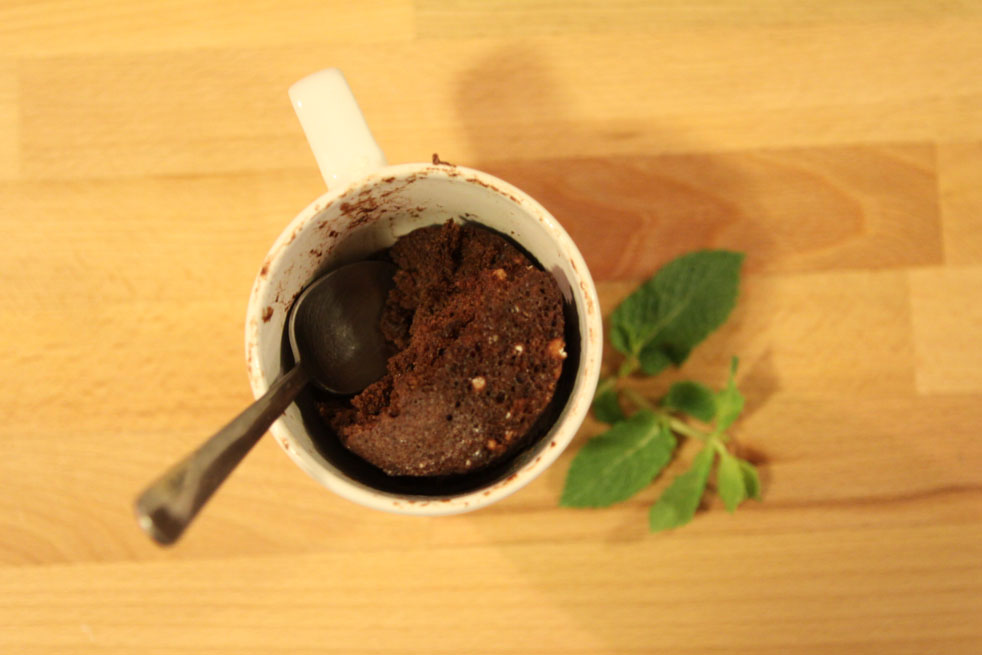

There’s something incredibly neat about a microwave cake. A cake tin full of batter takes 45 minutes or more to bake fully; a few ingredients in a coffee mug transform into a sweet treat in just sixty seconds. How does that magical humming box transform a liquid mixture into a single-serving dessert?
It starts, of course, with the microwave itself. Inside each oven, usually behind a small panel of mica or high-grade plastic on the right side of the machine, you’ll find a component called a magnetron. This device uses electricity from an outlet to generate microwaves, radio waves (RF) that have wavelengths ranging from one millimeter to one meter. The oven channels those RF waves into the box, where they penetrate any food inside.
Related: April 1968: Popular Science Tests the Brand-New Microwave Oven
The waves excite water molecules in the food, heating it up. A turntable continually rotates the dish, evenly distributing microwave energy throughout its contents. How does this affect your would-be cake? That depends on the ingredients you put into it.
Any fluffy baked good needs two components: architecture, the thing that gives it shape and structure, and a leavening agent, to make it rise. In this recipe, the architecture comes from gluten in the flour and rise from baking powder. (Author’s note: If you’ve ever wondered about the difference between baking powder and baking soda, think of the classic elementary-school volcano experiment, in which baking soda combines with acidic vinegar to form water and bubbles of carbon dioxide. Baking powder contains both baking soda and an acid, as well as corn starch to stabilize the components. When exposed to heat, the powder’s ingredients react, creating bubbles.) The trick to a perfectly cooked cake (in the microwave or in the oven) is making sure your architecture sets at the same time that your leavening agent—in our case, baking powder—forms air bubbles to make the batter rise.
Of course, you’ll need more than flour and baking powder to get a good microwave cake. Like a full-size cake, these desserts require additional liquid, sugar or another sweetener, and some sort of flavoring—our recipe uses vanilla extract and chocolate chips. And then there’s another key component: eggs.
Many recipes, including the one below, call for egg yolks without the whites. Yolks act as emulsifiers, allowing fats and liquids to combine. However, if your cake is too dry, you can try adding egg whites as well. Just be aware that proteins within the white can denature, or lose their structure, which affects the texture of the cake, according to Craig Nold, Principal Design Engineer, Cooking Product Development for GE Appliances. Although egg whites give some desserts extra lift, they won’t affect your mug cake’s architecture unless you beat them first, says Matt Hartings, a professor of chemistry at American University.
When you’re doling out these ingredients, Hartings says you should use a kitchen scale rather than cups and spoons. To demonstrate why to his students, Hartings performs an experiment on the first day of his “The Chemistry of Cooking” class. He asks the students to measure out two cups of flour, then weigh it. “There is a lot of variation, even when properly measured,” he explains. “Measuring is the way to go for precision.”
Ingredients aren’t the only things that will affect your cake’s success. The mug in which you cook it will also influence the final dessert. Hartings recommends using a small, narrow cylinder: The shape of the container forces the gas within the batter upwards, creating lift and forming the architecture your cake needs. And Nold notes that the material of your mug can also be a variable, since different materials will heat at their own rates based on cook time. However, with a 60-second cook time, mug material should not make a huge difference—just go with a standard ceramic one.
In addition, be careful how much batter you use. Nold says that, when recipe testing, you should actually cook with more batter, not less. Microwave energy is meant to excite water molecules within the food, so adding more batter will ensure there’s enough liquid to heat and distribute the energy.
Ultimately, a microwave cake is a science experiment you can perform at home. It may not always turn out perfect, but it will still be a warm, gooey treat you can enjoy. And you can always take notes, learn from your errors, and modify the recipe in the future.
Stats
- Time: About 5 minutes
- Cost: Depends how many ingredients you already have in your kitchen
- Difficulty: Easy
Ingredients
- 2 tbsp butter (28.25 grams)
- 1/4 cup flour (31.25 grams)
- 1 large egg yolk
- 2 tbsp white sugar (25 grams)
- 1 tbsp milk (15 grams)
- 1 tsp vanilla extract (5 grams)
- 1 tsp baking powder (4 grams)
- Optional: 2 tbsp chocolate chips (20 grams)
Instructions
- Put butter into a microwave-safe mug and melt it in your microwave. This should take 30 to 40 seconds.
- Combine the rest of the ingredients, except the chocolate chips, in the mug. Stir the mixture with a fork until you get a smooth batter.
- Add chocolate chips to the batter and stir again. (Author’s note: There’s no such thing as too many chocolate chips, so throw in a few extras for good measure.)
- Microwave the mixture for 60 seconds. At this point. the top should be firm. If it’s not, then microwave the cake in 10 second intervals until it is.
- Remove your dessert from the mug to share it with a loved one, or—let’s be honest—eat it straight out of the mug.
